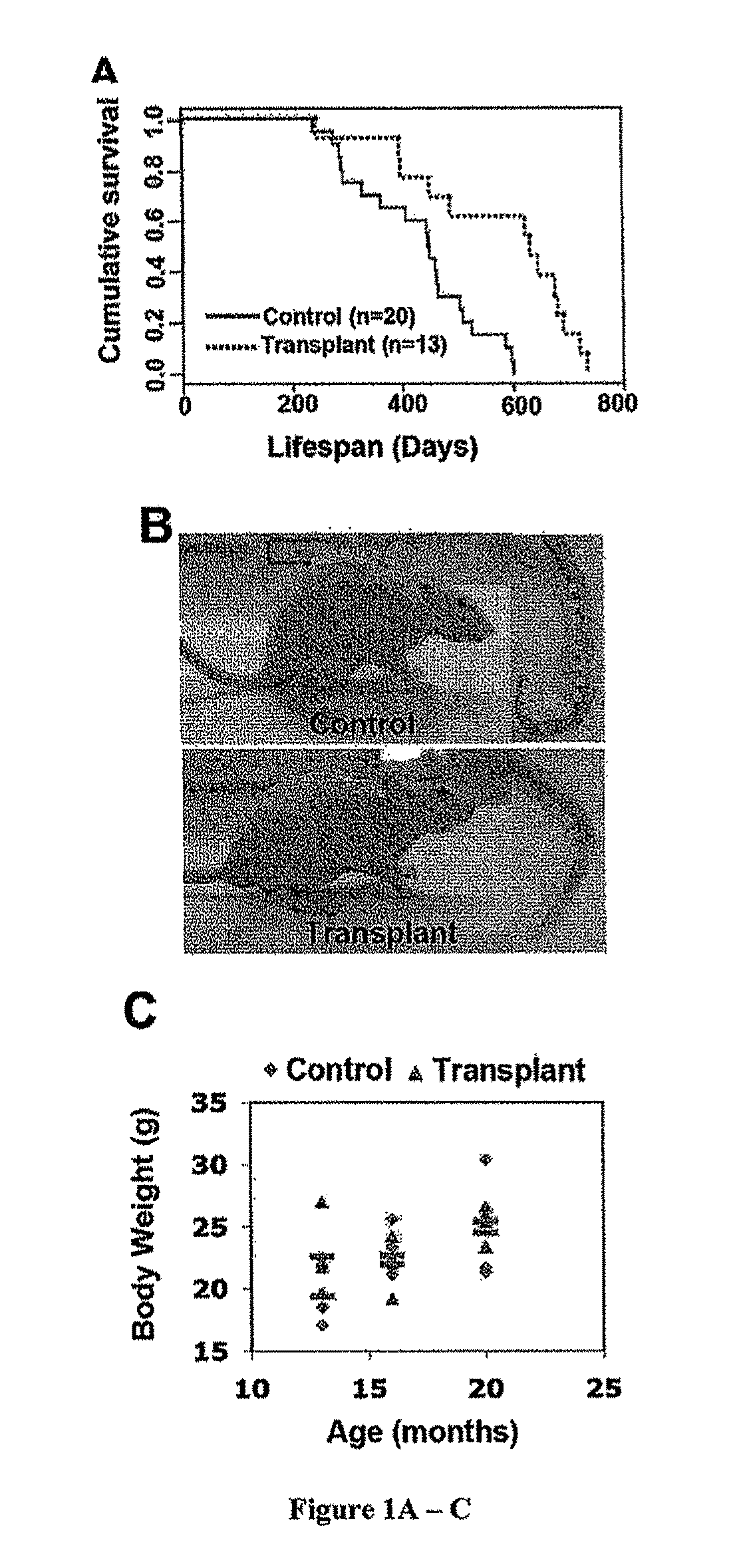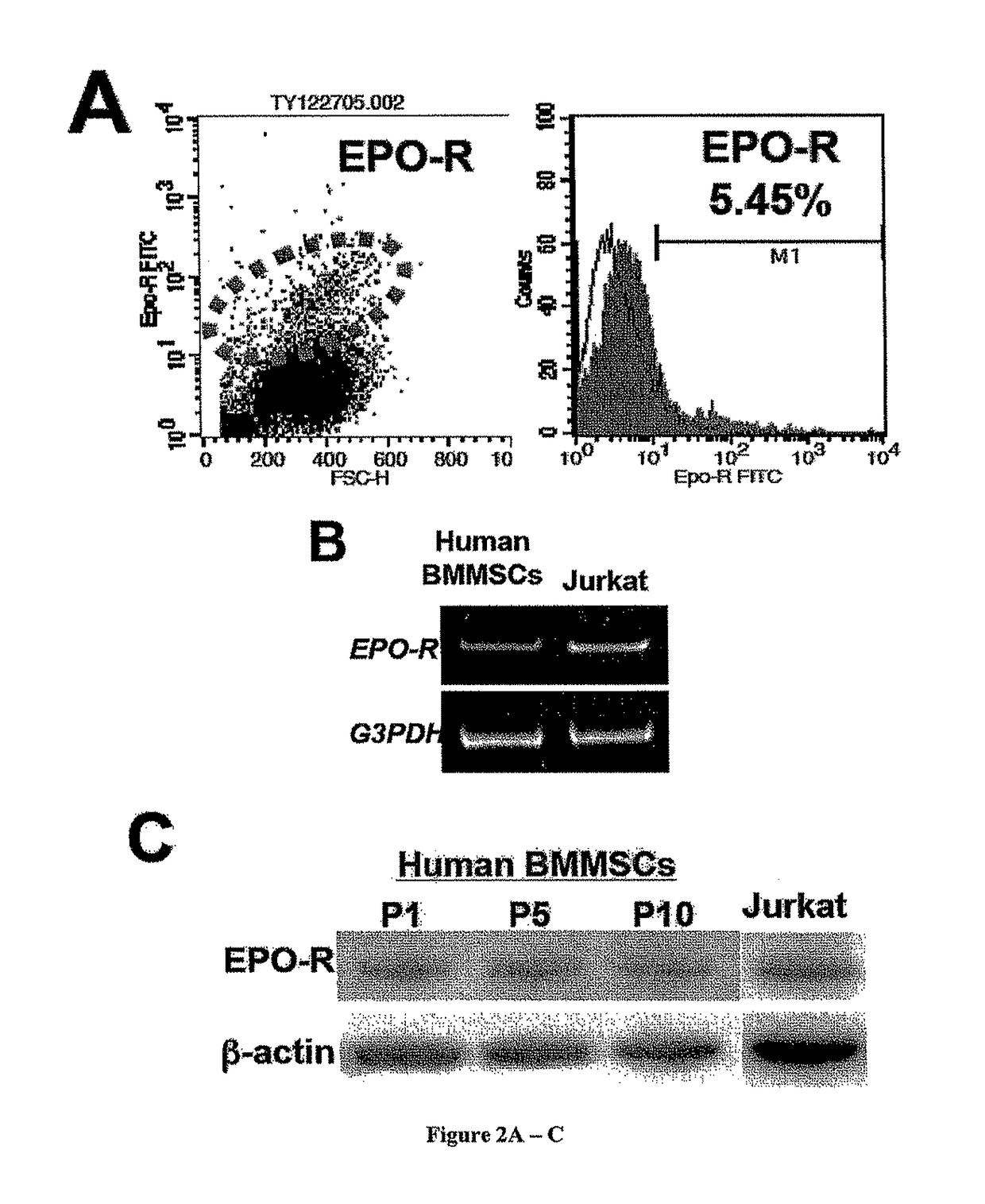Method for treating an SLE-like autoimmune disease in a human subject consisting of administering stem cells from human exfoliated deciduous teeth (SHED) and erythropoietin (EPO) to said human subject
a human subject and autoimmune disease technology, applied in the field of stem cell therapy and therapeutics, can solve the problems of cell therapy having the potential to dramatically change the treatment of human diseases, still exists a great deal of scientific and technical uncertainties surrounding stem cell research, and achieves the effect of improving the quality of life of subjects and prolonging the lifespan
- Summary
- Abstract
- Description
- Claims
- Application Information
AI Technical Summary
Benefits of technology
Problems solved by technology
Method used
Image
Examples
experiment 1
1.1 Ectopic BMMSC Transplant Extends Lifespan in Immunocompromised Mice
[0066]In this study, the inventors revealed that transplantation of BMMSCs with HA / TCP as a carrier subcutaneously into 6 month-old immunocompromised mice significantly extends lifespan, as compared to age-matched control mice (FIG. 1A).
[0067]The inventors analyzed survival using the Mantel-Haenszel test and found significantly greater overall survival of transplant recipient mice when compared to their littermates. The mean time to death was 355.7±74.5 days in 50% of control mice and 461.0±137.8 days in 50% of transplant recipients. The longevity of the recipient mice transplanted with BMMSC was significantly improved with an average extension of lifespan by 33.4% (p<0.01). Notably, the inventors observed an alleviation of a common natural aging process, shown here in 6 out of 9 control mice at 16 months of age, as a reduction in the vertebral curvature of the backs and the tails (FIG. 1B). These aging phenotype...
experiment 2
2.1 Systemic Lupus Erythematosus (SLE) Model MRL / Lpr Mice Showed BMMSC Impairment and Osteoblastic Niche Deficiency.
[0137]Osteoporosis is commonly reported in SLE patients secondary to long-term use of glucocorticoids and cyclophosphamide. We verified the osteoporotic changes in the skeletal structures of naïve CD95-mutant MRL / lpr mice by micro-radiographic and bone morphometric analyses. The femurs of MRL / lpr mice at age of 20 weeks showed remarkable reduction in BMD (FIG. 7A) and significant atrophy of trabecular bone (FIG. 7B) with reduced bone volume (FIG. 7C), trabecular number (FIG. 7D) and bone surface area (FIG. 7E) and increased trabecular separation (FIG. 7F). These findings indicated that the skeletal system of naïve MRL / lpr mice undergoes changes typical of osteoporosis phenotype.
[0138]Since T-lymphocyte over-activation has been associated with BMMSC impairment and osteoporosis, we next examined whether T-lymphocytes are over-activated in MRL / lpr mice and their effects o...
experiment 3
3.1 SHED Possess Mesenchymal Stem Cell Properties.
[0196]Although SHED are capable of differentiating into a variety of cell types, their detailed mesenchymal stem cell properties remain to be elucidated. Herein, we used flow cytometry, immunoblot analysis, and immunocytostaining analysis to demonstrate that SHED at passage 3 expressed many mesenchymal surface markers, including STRO-1, stage specific embryonic antigen 4 (SSEA4), CD73, CD105, CD146, and CD166 but were negative for CD34 and CD45 (FIGS. 13A-C). In comparison to BMMSCs, SHED expressed higher levels of STRO-1 and CD146, and lower levels of CD105 (FIG. 13A). Additionally, SHED showed significantly high numbers of CFU-F and an elevated cell proliferation rate compared to BMMSCs (FIGS. 13D and 13E). This elevated proliferative capacity may be associated with the significantly increased telomerase activity in SHED (FIG. 13F).
[0197]To compare osteogenic differentiation of SHED with BMMSCs, multiple colony-derived SHED at pass...
PUM
| Property | Measurement | Unit |
|---|---|---|
| thickness | aaaaa | aaaaa |
| pH | aaaaa | aaaaa |
| pH | aaaaa | aaaaa |
Abstract
Description
Claims
Application Information
 Login to view more
Login to view more - R&D Engineer
- R&D Manager
- IP Professional
- Industry Leading Data Capabilities
- Powerful AI technology
- Patent DNA Extraction
Browse by: Latest US Patents, China's latest patents, Technical Efficacy Thesaurus, Application Domain, Technology Topic.
© 2024 PatSnap. All rights reserved.Legal|Privacy policy|Modern Slavery Act Transparency Statement|Sitemap



